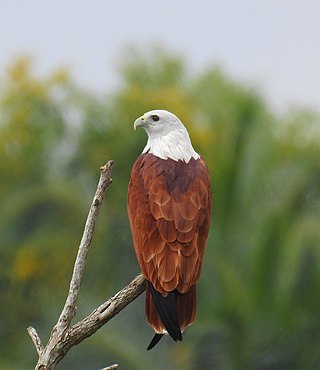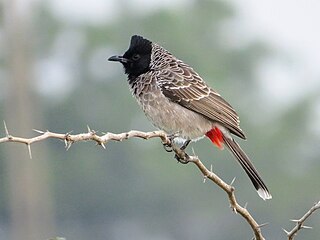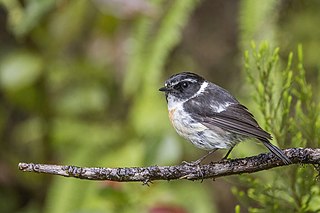
The brahminy kite, also known as the red-backed sea-eagle in Australia, is a medium-sized bird of prey in the family Accipitridae, which also includes many other diurnal raptors, such as eagles, buzzards, and harriers, all found in the Indian subcontinent, Southeast Asia, and Australia. The brahminy kite is found mainly on the coast and in inland wetlands, where it feeds on dead fish and other prey. Adults have a reddish-brown body plumage contrasting with their white head and breast which make them easy to distinguish from other birds of prey.

The brown shrike is a bird in the shrike family that is found mainly in Asia. It is closely related to the red-backed shrike and isabelline shrike. The genus name, Lanius, is derived from the Latin word for "butcher", and some shrikes are also known as "butcher birds" because of their feeding habits. The specific cristatus is Latin for "crested", used in a broader sense than in English. The common English name "shrike" is from Old English scríc, "shriek", referring to the shrill call.

The shikra is a small bird of prey in the family Accipitridae found widely distributed in Asia and Africa where it is also called the little banded goshawk. The African forms may represent a separate species but have usually been considered as subspecies of the shikra. The shikra is very similar in appearance, as well as behavior, at least to some degree, to other Accipiter species including the Chinese goshawk, Eurasian goshawk and Eurasian sparrowhawk. They have a sharp two note call and have the typical flap and glide flight. Their calls are imitated by drongos and the common hawk-cuckoo resembles it in plumage.

The pied thrush is a member of the thrush family found in India and Sri Lanka. The males are conspicuously patterned in black and white while the females are olive brown and speckled. They breed in the central Himalayan forests and winter in the hill forests of southern India and Sri Lanka. Like many other thrushes, they forage on leaf litter below forest undergrowth and fly into trees when disturbed and sit still making them difficult to locate.

The Jacobin cuckoo, also pied cuckoo or pied crested cuckoo, is a member of the cuckoo order of birds that is found in Africa and Asia. It is partially migratory and in India, it has been considered a harbinger of the monsoon rains due to the timing of its arrival. It has been associated with a bird in Indian mythology and poetry, known as the chātaka represented as a bird with a beak on its head that waits for rains to quench its thirst.

The white-browed wagtail or large pied wagtail is a medium-sized bird and is the largest member of the wagtail family. They are conspicuously patterned with black above and white below, a prominent white brow, shoulder stripe and outer tail feathers. White-browed wagtails are native to South Asia, common near small water bodies and have adapted to urban environments where they often nest on roof tops. The specific name is derived from the Indian city of Madras.

The red-vented bulbul is a member of the bulbul family of passerines. It is a resident breeder across the Indian subcontinent, including Sri Lanka extending east to Burma and parts of Bhutan and Nepal. It has been introduced in many other parts of the world and has established itself in New Zealand, Argentina, Tonga and Fiji, as well as parts of Samoa, Australia, USA and Cook Islands. It is included in the list of the world's 100 worst invasive alien species.

The yellow-billed babbler is a member of the family Leiothrichidae endemic to southern India and Sri Lanka. The yellow-billed babbler is a common resident breeding bird in Sri Lanka and southern India. Its habitat is scrub, cultivation and garden land. This species, like most babblers, is not migratory, and has short rounded wings and a weak flight and is usually seen calling and foraging in groups. It is often mistaken for the jungle babbler, whose range overlaps in parts of southern India, although it has a distinctive call and tends to be found in more vegetated habitats. Its name is also confused with Turdoides leucocephala, which is also known as white-headed babbler.

The Indian robin is a species of passarine bird in the family Muscicapidae. It is widespread in the Indian subcontinent and ranges across Bangladesh, Bhutan, India, Nepal, Pakistan and Sri Lanka. The males of the northern subspecies have brown backs whose extent gradually reduces southwards, with the males of the southern subspecies having all-black backs. They are commonly found in open scrub areas and often seen running along the ground or perching on low thorny shrubs and rocks. The long tail is usually held up and the chestnut undertail coverts and dark body make them easily distinguishable from pied bushchats and Oriental magpie-robins.

The Oriental magpie-robin is a small passerine bird that was formerly classed as a member of the thrush family Turdidae, but now considered an Old World flycatcher. They are distinctive black and white birds with a long tail that is held upright as they forage on the ground or perch conspicuously. Occurring across most of the Indian subcontinent and parts of Southeast Asia, they are common birds in urban gardens as well as forests. They are particularly well known for their songs and were once popular as cagebirds.

The Indian blue robin is a small bird found in the Indian Subcontinent. Formerly considered a thrush, it is now considered one of the Old World flycatchers in the family Muscicapidae. It was earlier also called the Indian blue chat. It is migratory, breeding in the forests along the Himalayas of Nepal, India, Myanmar and Bangladesh. They winter in the hill forests of the Western Ghats of India and in Sri Lanka.

Saxicola, the stonechats or chats, is a genus of 15 species of small passerine birds restricted to the Old World. They are insectivores occurring in open scrubland and grassland with scattered small shrubs.

The African stonechat or common stonechat is a species of the Old World flycatcher family (Muscicapidae), inhabiting sub-Saharan Africa and adjacent regions. Like the other chats, it was long assigned to the thrush family (Turdidae), to which the chats are convergent. Its scientific name refer to its appearance and habitat and means "collared rock-dweller": Saxicola from Latin saxum ("rock") + incola, torquatus, Latin for "collared".

The Nilgiri wood pigeon is large pigeon found in the moist deciduous forests and sholas of the Western Ghats in southwestern India. They are mainly frugivorous and forage in the canopy of dense hill forests. They are best identified in the field by their large size, dark colours and the distinctive checkerboard pattern on their nape.

The Indian pied myna is a species of starling found in the Indian subcontinent. It is usually found in small groups mainly on the plains and low foothills. It is often seen within cities and villages although it is not as bold as the common myna. It produces a range of calls made up of liquid notes.

The painted bush quail is a species of quail found in the hill forests of India. They move in small coveys on hillsides and are distinguished by their red bills and legs. They have a liquid alarm call and small groups will run in single file along paths before taking flight when flushed.

The baya weaver is a weaverbird found across the Indian Subcontinent and Southeast Asia. Flocks of these birds are found in grasslands, cultivated areas, scrub and secondary growth and they are best known for their hanging retort shaped nests woven from leaves. These nest colonies are usually found on thorny trees or palm fronds and the nests are often built near water or hanging over water where predators cannot reach easily. They are widespread and common within their range but are prone to local, seasonal movements mainly in response to rain and food availability.

The white-browed bush chat, also known as Stoliczka's bushchat, is an Old World flycatcher in the genus Saxicola. The alternative name is after the discoverer, geologist and explorer Ferdinand Stoliczka.

The Réunion stonechat is a species of stonechat, endemic to the island of Réunion. This small passerine bird is common in clearings and open mountain bushlands there up to 2600 metres above sea level, including in the plains around Piton de la Fournaise.

The Madagascar stonechat is a species of stonechat, endemic to Madagascar. It is a small bird, closely similar to the African stonechat in both plumage and behaviour, but distinguished from it by the more extensive black on the throat and minimal orange-red on the upper breast of the males.

























